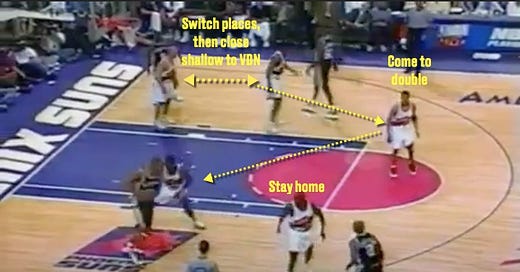Basketball diaries: When speed lets size win
Every so often, I'll type up notes from one of the many games I watch. Today, we go back to 1998 for a classic battle between big and small.

As we wait for the NBA to (probably) make a (possibly ill-advised) return to play, I figured I should share my notes on some of the individual games I watch. You get a taste of my thought process in real time, and I get to internalize those observations the same way a student does when typing up class notes before a test. Retro games only to start, but that’ll change if/when the season resumes. The first couple will be free to all, but I’ll probably restrict access to paid subscribers in the future.
Speaking of, here’s how to become a paid subscriber!
And for those looking for last-minute Father’s Day gifts.
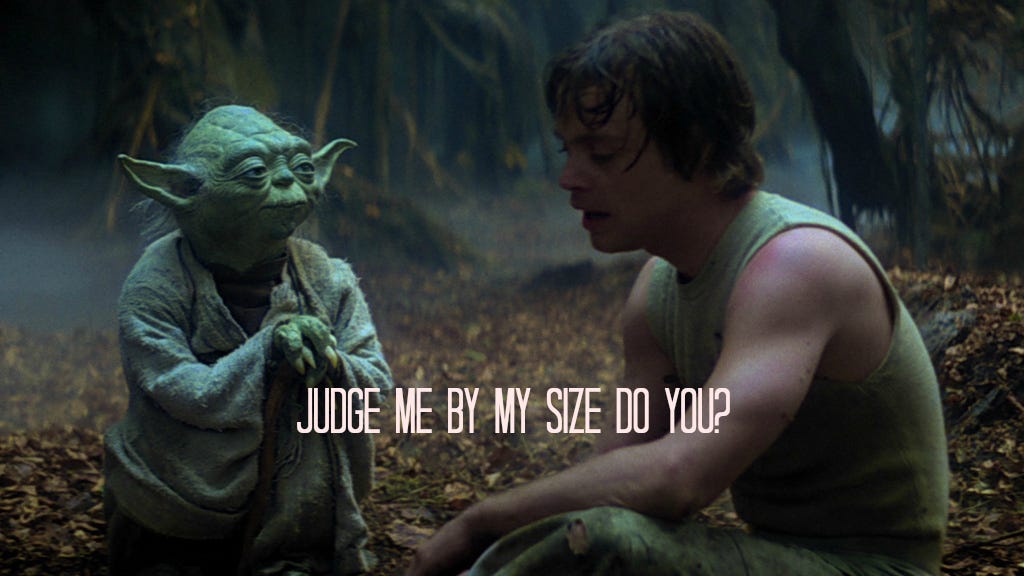
Today’s game notes are from Game 1 of the 1998 NBA Western Conference first-round series between the fourth-seeded Phoenix Suns and fifth-seeded San Antonio Spurs. This was Tim Duncan’s playoff debut. After struggling with foul trouble in the first half, Duncan dominated down the stretch to give the Spurs a 102-96 victory. San Antonio eventually won the best-of-five series in four games before falling to the Jazz in the second round.
I chose this game because it featured a fascinating contrast in styles. The Spurs used a ridiculous three seven-foot center starting lineup, with plodding Will Perdue acting as the “small forward” alongside Duncan and David Robinson. The Suns started two point guards and two power forwards, and sometimes even played three little guys at once. We’re more familiar with these kinds of size vs. speed battles today, but they were less common in 1998.
How would this one play out? Let’s jump back 22 years. Kevin Harlan and Quinn Buckner are on the call for TNT. Here’s the full game. (Timestamps refer to the mark in that video, not the time in the game. That should make it easy for you to follow along with me).
PREGAME
We have to talk about some injuries. The Suns lost Sixth Man of the Year Danny Manning to another torn ACL in late April, while the Spurs elected not to rush starting small forward Sean Elliott back after he underwent knee surgery for the second straight season. Phoenix also played without leading scorer Rex Chapman, who pulled his hamstring late in the season. Chapman dressed in Game 1, but didn’t play. (On the telecast, Buckner suggested that Suns coach Danny Ainge wanted to preserve Chapman for later in the series. That didn’t exactly work out: Chapman started in Phoenix’s Game 2 win, but reaggravated his injury in their Game 3 defeat and missed Game 4).
Phoenix started veteran Kevin Johnson in Chapman’s place alongside Jason Kidd in the backcourt, sharp shooter George McCloud at small forward, and Clifford Robinson and Antonio McDyess up front. San Antonio countered with their three seven-footers, plus pint-sized Avery Johnson and 3-and-D specialist Jaren Jackson.
FIRST HALF
3:22 — Wary of McCloud’s shooting, Gregg Popovich made a way-ahead-of-its-time decision and had Duncan guarding Kidd. Better to make Ason (no J) shoot from the perimeter when Duncan inevitably helped at the rim. That’s exactly what happened after Duncan helped on an Uncle Cliffy/McDyess two-man action at the top of the key, and Kidd obliged by bricking a wide open wing three.
(Note: we’ll use “Uncle Cliffy” to refer to Clifford Robinson, “The Admiral” for David Robinson, “Avery” for Avery Johnson, and “KJ” for Kevin Johnson).
But there is a consequence to San Antonio’s matchups. Perdue and The Admiral switched the initial middle pindown, and in trying to recover, Perdue got stuck on the wrong side of McDyess. That opened up this easy offensive rebound.

The Suns got a number of early putback opportunities because the Spurs’ bigs were too slow to switch back properly. Offensive rebounding is sometimes about quickness, not size.
8:28 — You see this high pick-and-pop alignment a lot today against teams that drop their big men back like the Spurs. The difference is that it results in a long two in 1998 instead of a three or a dribble handoff to the wing in 2020.

9:42 — As we were saying …

That shot missed, and then it was the Spurs’ chance to punish cross matches on the break. Jackson is defending McCloud on the right wing, but Perdue is McCloud’s assignment on the other end. When the Spurs break out 4 on 4, McCloud runs to his man, but fails to inform McDyess. That gives The Admiral a lane to the rim, and Kidd is far too small to effectively pinch in and stop this lob.

13:26 — This is a beautiful move, especially on replay. But how are the Suns allowing The Admiral to turn-and-face, ball fake, and blow by Uncle Cliffy without any help? The Spurs are playing four non-shooters, three of which are 7-foot centers! This’ll be a theme later on.

18:50 — The Suns run a nifty misdirection play to take advantage of The Admiral sinking in the lane. They decoyed to the left, then ran McCloud off a curl into the middle of the lane. They should have the Spurs dead to rights here.

But instead of rolling hard to the rim or fading back for an open jumper, Uncle Cliffy gets caught in between and ends up forcing a runner over The Admiral. Space is only effective if you use it properly.
23:48 — TNT’s overhead replay shows the value of proper floor spacing. McCloud is a step closer to sharp-shooter Chuck Person than he would be against anyone else. That means that he’s too slow to react when Avery cuts to the rim after Steve Nash double-teams Duncan.

Buckner blames Nash for turning his head, but this was McCloud’s fault.
25:51 — Steve Nash … posting up? And drawing a double-team? Basketball in the 90s was weird.
29:11 — Duncan is back on Kidd, but not for much longer. The Suns have run guard/guard screens on the left side all game to force the Spurs into tricky matchup decisions. Instead of switching, the Spurs ask Duncan to slide under the pick. But Nash makes just enough contact for Kidd to get a step on Timmy and draw a crucial third foul. That’ll be the end of Duncan guarding Kidd.
30:32 — Dennis Scott was on the Suns? When did that happen?
Anyway, his presence becomes key to opening the Suns’ deadly transition game. With Scott and Nash spread out to the three-point line, Kidd has all the room he needs to surge to the hoop and draw a foul. This looks like a 2020 Bucks fast break.

33:23 — Remember last week’s discussion on the decline of the outlet pass? This sequence is a proto-modern illustration of why we don’t see it much anymore. The Suns force a long jumper that caroms into a long rebound beyond the crashing Spurs players. KJ picks it up and immediately surges up the court rather than wasting time finding a teammate.
As he does that, keep an eye on Mark Bryant and Scott. They immediately turn and sprint to force the break, creating a 2-on-1 situation on the opposite side against the retreating Perdue. As Bryant continues his run, Scott sneaks to the line and drains an open transition three. Suns by 11.

The Suns are able to create that two-on-one because Bryant and Scott run instantly, trusting KJ to make a play with the ball. KJ, of course, can do just that.
The Suns needed to play two point guards to create this effect in 1998. They wouldn’t need to these days because most bigs today can do exactly what KJ just did.
39:05 — San Antonio’s spacing is becoming an issue. The Suns are pressing and The Admiral isn’t exactly Draymond Green bringing the ball up. This time, the Suns trap Vinny Del Negro and help off the other three Spurs to eliminate his passing angles. Perdue must be more of a threat.
39:52 — Key sequence here. The Suns force another long miss, but the Spurs get back well enough to prevent Scott from stepping into another three. As Buckner credits the Suns for pulling the ball back out, they end up creating a wild Kidd reverse flippy thing at the end of the shot clock.
Another transition hoop would’ve pushed the lead to 13 or 14. Instead, the Spurs got to call timeout and regroup. In hindsight, this was a big momentum-changer.
44:52 — Fun chess game alert! The Suns have Scott screen for Kidd to get Person to switch. Person responds by yielding the baseline, funneling Kidd into The Admiral. Adjustment, counter-adjustment.
When the Suns tried this with KJ a couple plays earlier, The Admiral swallowed his hard drive up and forced a turnover. But this time, Kidd steps into Person to at least get the angle for a shot. He misses, but getting it on the rim allows Bryant to wedge Perdue under the hoop on the opposite side for the putback.
I’m gonna slow these clips down so you can see Kidd’s steps compared to KJ’s. Footwork made all the difference.

46:09 — Uncle Cliffy, who’s been brutal since re-entering the game, allows sub Malik Rose to sneak inside of him for a free-throw offensive rebound that eventually leads to an Admiral spin-and-slam. The Suns’ 11-point lead is down to 5 at halftime, and Duncan hasn’t played since early in the second quarter. Remember that the Spurs eventually win by six.
THIRD QUARTER
52:14 — Gregg Popovich switches Duncan onto McCloud instead of Kidd to save his rookie star from further foul trouble. The Suns run two early pick-and-pops for McCloud that lead to a converted long two and a missed semi-contested three. The Spurs will live with those shots.
54:38 — More transition confusion from the Suns. McCloud hesitates for mayyybe half a second instead of picking up The Admiral. That triggers Kidd to rotate down off Jackson, which leads to this three and a San Antonio lead.

The tiniest bit of indecision can have dramatic consequences.
57:54 — McDyess, who has been silent so far, bizarrely tries to back Perdue down instead of turning and facing. The result is a wild fadeaway brick that leaves two Suns out of the play on the rebound. Their transition defense is compromised and they yield a coast-to-coast Avery layup.

1:01:22 — Beautiful Spurs out of bounds play. They set up a sideline triangle, slice Duncan off a Perdue backscreen, then run a side pick-and-roll with Perdue and Avery. The beauty of the play is that as Avery draws help, Duncan has a step on McDyess and is easily able to pin him under the hoop thanks to Perdue’s first screen. Admiral delivers a perfect hi-lo bounce pass and Duncan scores easily.

1:07:55 — McDyess is getting more involved offensively, which is good. But that shouldn’t give him license to take this shot instead of swinging it to McCloud on the wing.

1:11:21 — Why is Duncan allowed to go one-on-one against Hot Rod Williams? Why not have McCloud dig off his man and McDyess roam off Perdue to account for Person? What good is your collective team quickness if you won’t use it?
FOURTH QUARTER
1:16:26 — Illegal defense was such a dumb rule. It made defensive strategies less interesting and encouraged teams to turn their worst offensive players into statues. Monty Williams can’t do anything out here. He even has his hands on his knees! But because of the illegal defense rule, McCloud must choose between fully double-teaming Duncan on the block or standing above the free-throw line to “guard” Williams. Either way, San Antonio is rewarded for having one of its five players doing absolutely nothing.
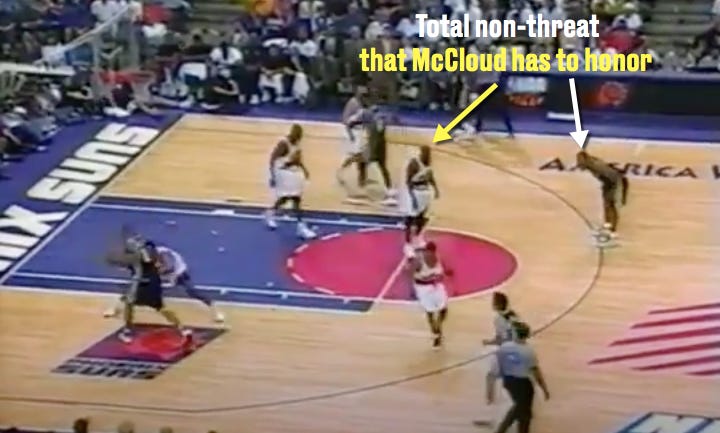
The Suns could still pressure Duncan by having KJ double and McCloud shift slightly to Vinny Del Negro. But then the Spurs would just stand still, point at McCloud, and shout at the refs to make the illegal defense call. That’s a point and the ball, all for a non-basketball move. It was worse than Hack-A-Shaq. The best thing the league ever did was to do away with that rule.
As is, the threat of illegal defense allows Duncan to go at Hot Rod one-on-one and score off the glass. Wouldn’t the game be more interesting if the Suns had more ways to make the Spurs pay for playing Williams?
Anyway, Duncan is rolling now and that’s trouble for the Suns.
1:22:06 — Ever wonder how simple set plays like this yield such open shots? Here’s why:

The Suns have shown the Spurs that very floor alignment every time down since the end of the third quarter. Typically, Kidd cuts off the big man and curls to the corner while the other point guard runs a middle pick-and-roll. The Spurs got used to anticipating that action.
But this time, Kidd stayed where he was, took the ball back, and caught San Antonio napping on a curl for Scott on the opposite side.
There’s nothing remarkable about this play on its own. Anyone can stop a pindown screen. But the twist works precisely because the Suns have primed the Spurs to expect something very different from that alignment.
(This is one reason I always watch games start to finish instead of picking up in the middle. It’s the only way to spot the crucial context clues that make certain plays work and others fail.)
1:22:40 — This is the sexiest thing I’ve seen today.
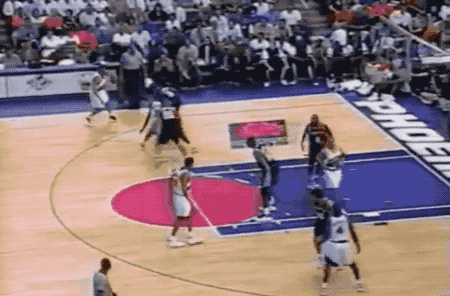
1:27:07 —Duncan goes between the legs to stagger Hot Rod back, advances middle to his position, then freezes him with a drop step off the glass. This savagery is illegal in 48 states.
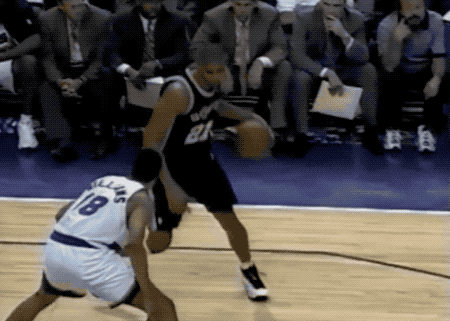
But Duncan’s able to do all that because THE SUNS WON’T DOUBLE-TEAM FOR SOME REASON.
1:27:48 — The Spurs position three guys at the top of the key, toss the ball into Duncan, then have Avery cut through to the opposite corner. Duncan toasts Hot Rod again. Hey Suns, have you considered double-teaming?
1:28:32 — As Avery and Admiral cluster in the opposite corner, Duncan jab-steps Hot Rod and kisses a jumper off the glass. Spurs by 3. Hey Suns, have you considered double-teaming?
1:30:36 — Same basic Spurs alignment. Same single coverage. Same result: two points for Duncan. Harlan and Buckner go nuts. It’s a beautiful moment. Hey Suns, have you considered double-teaming? Duncan has 14 points on 7-7 shooting in the quarter, mostly against single coverage. It’s well past time to make someone else beat you.
I guess I should offer something more constructive. I see three alternate ways the Suns could have played this. One is to ask Kidd to double team off Avery from the opposite baseline. AJ and the Admiral were close enough to each other that Bryant could probably play both at once even if one cut to the rim. That’s the simplest approach.

Or … the Suns could have McCloud double, ask KJ to rotate to Jackson, then get Kidd or Bryant to close out on Del Negro if the Spurs swung the ball.
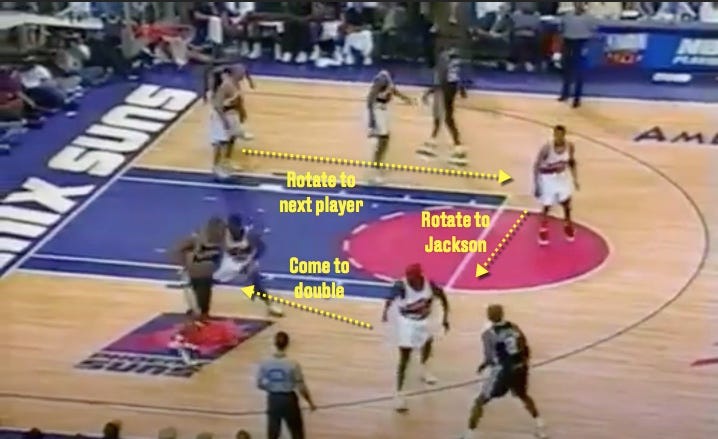
If they really wanted to get spicy, they could have KJ double from the top of the key off Del Negro and ask Kidd or Bryant to close hard in the event of a diagonal pass. This would’ve been my pick because Del Negro was more of a long two-point shooter anyway. Maybe Kidd wouldn’t need to actually close hard to him. Maybe it’s not so bad to make Del Negro beat you considering he barely touched the ball in the quarter.

Any of those three strategies would’ve been a better use of the Suns’ quickness. They would have scrambled the game, and the Suns thrived in those situations. Instead, the Suns allowed the Spurs to dominate inside and got beat. Size matters not … unless the small team doesn’t use the advantages their lack of size offers.
1:35:26 — Forced by their own doing to play a half-court game, the Suns had to walk the ball up in the fourth quarter. Without Chapman to draw the Spurs’ attention, the Suns’ half-court offense stalled. San Antonio roamed off Kidd or KJ to effectively shut down Phoenix’s pick-and-roll and happily switched any guard/guard screens.
The Suns’ one chance in transition got foiled by a dogged Avery closeout on McCloud. This is some hustle play.

1:37:06 — Down six with 1:20 left, the Suns post up Avery with Kidd. They got The Admiral to come on the double team, but Uncle Cliffy and Bryant are standing too close together on the opposite side, allowing Del Negro to play both at once. Kidd’s pass to a cutting Uncle Cliffy is low and Admiral recovers for the block. That poor spacing wouldn’t happen today.
1:37:41 — The Suns somehow get another chance after the Spurs gift Kidd two turnovers. The second turns into a 2-on-1 fast break with KJ, who is fouled with 45.4 seconds left. If KJ — who shot 87 percent from the line that season — makes both free throws, the Suns cut the deficit to two and don’t need to foul on the ensuing Spurs possession.
KJ misses both. That’ll do it.
The Spurs’ size won this battle and the series, but only because the Suns allowed them to win their way. While it was much easier to play big in the 90s, there were still plenty of ways the Suns could have scrambled the game. They only did it for a brief stretch in the second quarter, and that proved to be their undoing. Size matters not, but strategy does.
Enjoy this? Let me know which game you want me to break down next.

